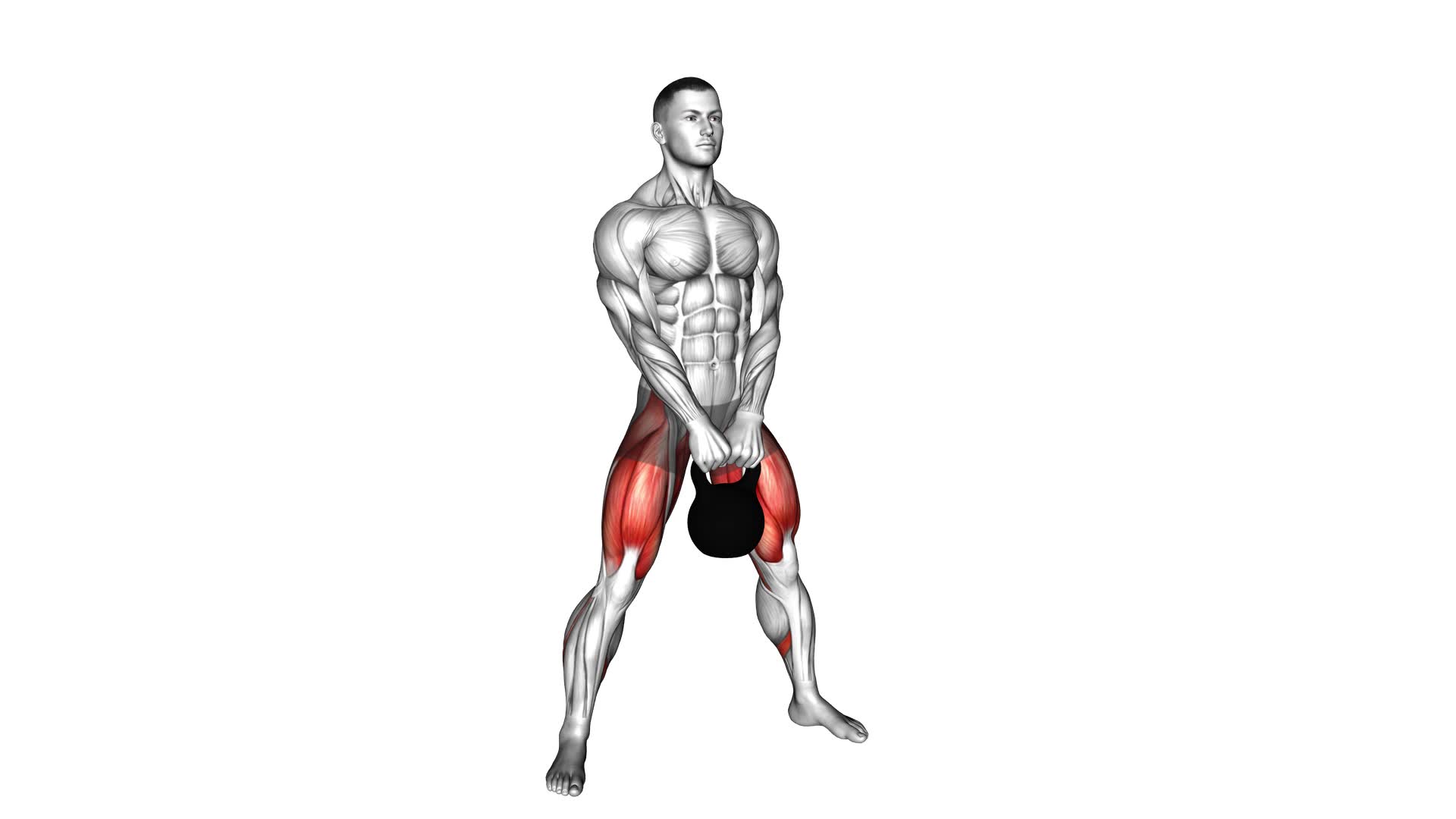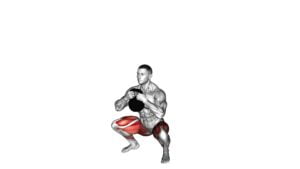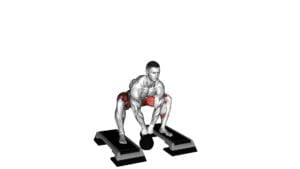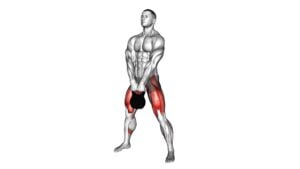Kettlebell Sumo Squat (VERSION 2) – Video Exercise Guide & Tips

Are you looking to level up your lower body workout routine? Look no further than the kettlebell sumo squat (version 2).
Watch This Exercise Video
This powerful exercise targets your quads, glutes, and hamstrings all at once, helping you sculpt strong and toned legs.
In this video exercise guide, we'll show you the proper form and technique, variations and modifications to try, common mistakes to avoid, and tips for maximizing your results.
Get ready to feel the burn with this challenging yet rewarding move.
Let's get started!
Key Takeaways
- Kettlebell Sumo Squat targets quads, glutes, and hamstrings simultaneously.
- It helps sculpt strong and toned legs.
- Engages multiple muscle groups for a full-body workout.
- Gradually increase weight and focus on proper technique for optimal results.
Benefits of Kettlebell Sumo Squat (Version 2)
Experience the incredible benefits of the Kettlebell Sumo Squat (Version 2) to strengthen multiple muscle groups and improve overall lower body stability. This exercise specifically targets the muscles in your legs, glutes, and core. By incorporating the use of a kettlebell, you add an extra challenge to your workout, increasing the intensity and effectiveness of the exercise.
The Kettlebell Sumo Squat (Version 2) is a fantastic way to engage your quadriceps, hamstrings, and glutes. As you lower your body into a deep squat position, these muscles are activated and strengthened. Additionally, the wide stance of the sumo squat targets your inner thighs, further toning and sculpting your lower body.
Not only does this exercise build strength, but it also enhances your stability. The Kettlebell Sumo Squat (Version 2) requires you to maintain proper form and balance throughout the movement. By consistently performing this exercise, you'll develop better stability and control over your lower body, reducing the risk of injury during other activities or sports.
Now that you understand the incredible benefits of the Kettlebell Sumo Squat (Version 2), let's move on to discussing the proper form and technique to maximize your results and ensure safety during your workouts.
Proper Form and Technique
To perform the Kettlebell Sumo Squat (Version 2) with proper form and technique, follow these steps.
- Start by standing with your feet wider than shoulder-width apart, toes pointing slightly outwards.
- Hold the kettlebell with both hands, allowing it to hang between your legs.
- Engage your core and keep your back straight throughout the exercise.
- Begin the movement by bending your knees and lowering your body into a squat position, keeping your weight in your heels.
- Make sure your knees stay in line with your toes, and avoid letting them collapse inward.
- As you descend, the kettlebell should drop down between your legs.
- Once you have reached the bottom position, pause for a moment before pushing through your heels to return to the starting position, fully extending your hips.
- Remember to maintain control and avoid any jerky or sudden movements.
To ensure proper form and technique, it's important to be aware of common mistakes.
- One common mistake is allowing your knees to cave inwards, which can put unnecessary stress on your joints.
- To prevent this, focus on pushing your knees outwards as you squat.
- Another mistake is rounding your back, which can lead to injury.
- Keep your chest lifted and your back straight throughout the movement.
- Additionally, avoid letting your heels come off the ground, as this can destabilize your position.
- To maintain stability, keep your weight evenly distributed through your feet.
Here are some tips and tricks to help you perform the Kettlebell Sumo Squat (Version 2) effectively.
- First, start with a lighter kettlebell to ensure proper form before progressing to a heavier weight.
- This will allow you to focus on your technique without compromising safety.
- Second, engage your glutes and hamstrings as you push through your heels to stand up from the squat position.
- This will help maximize the benefits of the exercise.
- Finally, incorporate this exercise into your leg and glute workouts for a well-rounded lower body routine.
- By following these tips and avoiding common mistakes, you can perform the Kettlebell Sumo Squat (Version 2) with proper form and technique.
Variations and Modifications
For different ways to challenge yourself or modify the exercise, try these variations of the Kettlebell Sumo Squat (Version 2).
If you're looking to increase the intensity of your workout, you can try using a heavier kettlebell. This won't only work your lower body muscles harder but also increase the amount of resistance during the exercise.
Alternatively, if you're just starting out or prefer a lower impact workout, you can use a lighter kettlebell or even just your body weight. This will still engage your muscles and give you a great workout without putting too much strain on your joints.
Another variation you can try is the Kettlebell Sumo Squat with a pulse. After you lower yourself into the squat position, instead of immediately standing back up, do a small pulse by moving up and down a few inches. This will further challenge your muscles and increase the burn.
Lastly, if you want to target your inner thighs more, you can try the Kettlebell Sumo Squat with abduction. As you lower yourself into the squat position, lift one leg out to the side and then bring it back in as you stand up. This will engage your inner thigh muscles more and provide a different challenge to your workout.
Remember to always listen to your body and choose the variation that works best for you.
Common Mistakes to Avoid
Avoid these common mistakes when performing the Kettlebell Sumo Squat (Version 2) to ensure proper form and maximize your workout results. Technique errors can hinder your progress and increase the risk of injury.
One common mistake is rounding your back during the squat. This puts excessive strain on your lower back and can lead to pain or injury. To avoid this, maintain a neutral spine throughout the movement by engaging your core and keeping your chest lifted.
Another mistake to avoid is allowing your knees to cave inwards. This places undue stress on your knee joints and can lead to discomfort or injury. Instead, focus on pushing your knees outwards and maintaining proper alignment with your toes.
Lastly, be mindful of using too heavy of a kettlebell. This can compromise your form and make it difficult to perform the squat correctly. Start with a lighter weight and gradually increase as you become more comfortable and confident in your technique.
By avoiding these common mistakes, you can perform the Kettlebell Sumo Squat (Version 2) with proper form and maximize your workout results.
Now that you're aware of the common mistakes to avoid, let's move on to some tips for maximizing your results.
Tips for Maximizing Results
To optimize your results with the Kettlebell Sumo Squat (Version 2), focus on these key tips for maximum effectiveness.
First, it's important to address some common misconceptions. Contrary to popular belief, the Kettlebell Sumo Squat (Version 2) isn't just for advanced athletes. It can be modified to suit individuals at different fitness levels. Another misconception is that heavy weights are necessary to see results. While using heavier kettlebells can increase the intensity, it's crucial to prioritize proper form and technique over weight.
Now, let's discuss the best time to perform the exercise. The Kettlebell Sumo Squat (Version 2) is a compound exercise that engages multiple muscle groups, making it an excellent choice for full-body workouts. It can be incorporated into your routine as a warm-up exercise to activate your lower body muscles, or as a standalone strength exercise. You can also include it in your circuit training or interval training sessions for an added challenge.
Remember to listen to your body and start with a weight that's manageable for you. Gradually increase the weight as you get stronger and more comfortable with the movement.
Incorporating these tips into your Kettlebell Sumo Squat (Version 2) routine will help you maximize your results and achieve your fitness goals.
Frequently Asked Questions
How Many Calories Can I Burn by Performing Kettlebell Sumo Squat (Version 2)?
You can burn a significant number of calories by performing kettlebell sumo squats (version 2).
Incorporating these squats into your full body workout routine has many benefits.
Not only do they target your lower body muscles, but they also engage your core and improve balance.
To maximize calorie burn, be sure to use proper form.
Keep your back straight, chest lifted, and knees in line with your toes.
Engage your glutes and push through your heels as you rise back up.
Can Kettlebell Sumo Squat (Version 2) Help in Reducing Belly Fat?
Kettlebell sumo squats can be a great addition to your fitness routine if you're looking to reduce belly fat. By incorporating these variations into your workout, you engage multiple muscle groups, including your core, which can help strengthen and tone your abs.
Additionally, kettlebell sumo squats are a high-intensity exercise that can increase your heart rate and burn calories, contributing to overall fat loss.
Is It Necessary to Use a Kettlebell While Performing Sumo Squats?
Yes, it's necessary to use a kettlebell while performing sumo squats. The kettlebell adds resistance to the exercise, making it more challenging and effective for building strength and muscle in your lower body.
However, if you don't have access to a kettlebell, there are alternative options you can try, such as using a dumbbell or a resistance band. These alternatives can still provide a similar level of intensity and help you achieve your fitness goals.
Can Kettlebell Sumo Squat (Version 2) Improve My Cardiovascular Fitness?
Using kettlebell sumo squats (version 2) can improve your overall strength and endurance while also providing cardiovascular benefits. It's an effective exercise that engages multiple muscle groups and increases your heart rate.
Compared to other cardiovascular exercises, kettlebell sumo squats offer a unique challenge as they require stability and control. Incorporating this exercise into your routine can help you achieve your fitness goals and improve your cardiovascular fitness.
Are There Any Specific Muscles Targeted by Kettlebell Sumo Squat (Version 2) That Are Not Mentioned in the Article?
When it comes to the kettlebell sumo squat (version 2), the article may have missed mentioning a few muscles that are specifically targeted. Two of these muscles are the adductor muscles and the gluteus medius.
These muscles play an important role in stabilizing your hips and thighs during the exercise. By working these muscles, you can further enhance the effectiveness of the kettlebell sumo squat (version 2) and achieve better overall strength and toning.
Conclusion
In conclusion, the kettlebell sumo squat (version 2) is a highly beneficial exercise that targets the lower body muscles, enhances strength and stability, and improves overall fitness.
By maintaining proper form and technique, individuals can maximize the effectiveness of this exercise.
Additionally, variations and modifications can be incorporated to add variety and challenge to the workout.
Avoiding common mistakes and following the provided tips can help individuals achieve the best results from this exercise.

Author
Years ago, the spark of my life’s passion ignited in my mind the moment I stepped into the local gym for the first time. The inaugural bead of perspiration, the initial endeavor, the very first surge of endorphins, and a sense of pride that washed over me post-workout marked the beginning of my deep-seated interest in strength sports, fitness, and sports nutrition. This very curiosity blossomed rapidly into a profound fascination, propelling me to earn a Master’s degree in Physical Education from the Academy of Physical Education in Krakow, followed by a Sports Manager diploma from the Jagiellonian University. My journey of growth led me to gain more specialized qualifications, such as being a certified personal trainer with a focus on sports dietetics, a lifeguard, and an instructor for wellness and corrective gymnastics. Theoretical knowledge paired seamlessly with practical experience, reinforcing my belief that the transformation of individuals under my guidance was also a reflection of my personal growth. This belief holds true even today. Each day, I strive to push the boundaries and explore new realms. These realms gently elevate me to greater heights. The unique combination of passion for my field and the continuous quest for growth fuels my drive to break new ground.



